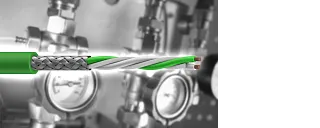Change Language :

Special cables
We developed the CFSPECIAL cable group for use in special applications. For special moving applications, only special cables can be used as they go beyond normal energy supply. However, this always means a minimum production quantity, which is usually unrealistic, especially for maintenance customers or very small applications. What is special about the CFSPECIAL family is that it is available as standard catalogue cables and can therefore be supplied quickly. This product range is slightly narrower, but we can expand it quickly if required. So, if you have trouble finding the right cable for your specific application, we would be pleased to hear from you directly.
Portrait of special cables

To give you an overview of what is already possible today, we will briefly present all our cable families, which you will find in the section on special cables. We would like to continually adapt this area to meet customer requirements, so we are open to new challenges. Challenge us. For more information, visit our blog
Thermal compensation cable: A thermal compensation cable is the connection between a thermocouple and a measuring device. The thermal compensation cable must be made of the same materials as the thermocouple. Otherwise the measurement would be falsified due to unwanted additional thermoelectric voltages.
CFFLAT: This cable has been specially developed for small installation spaces where large core cross-sections are still required. We use a flat cable design with a braided conductor in the core.
Cable for high tensile strength applications: Under part number CFSPECIAL.182 is our high tensile strength cable. With built-in aramid braiding in the outer jacket, this cable can withstand a tensile force that is 15,000% higher than the standard.
7th axis cables: A cable for supplying the entire robot when it is assembled on a so-called 7th axis. This is the axis that allows the robot to move along with the workpiece. The cable assemblies comply with the electrical specifications of the robot manufacturer.
The CFSPECIAL package explained quickly and simply
Solution for high tensile strain

The tensile strength that may act on a cable is described in the standard DIN VDE 0298 Part 3 Point 7.1. Simply put, this states that according to VDE it is permissible to load the cable with a tensile strength of 15N per 1mm main core. This means, for example, that a cable with a 4G1.0 structure may be subjected to a force of 4x1x15N, i.e. 60N. It does not matter whether this force is generated e.g. by a spring used to tension the cable or by the weight of a freely suspended cable. If higher forces occur, these must be absorbed by an external load-bearing element. This is what we do with the CFSPECIAL.182. A special support braid is moulded into its two-layer outer jacket, which absorbs incredible forces of up to 15,000% above the standard. This has been proven by a free-hanging Ethernet cable over 11 floors for many years. Here you will find the application that may outline a solution for you.
Do you already know our online tool?
Easy to find, select the right type, calculate service life and order online

Product finder
Find exactly the right cable quickly

Service life calculator
Calculate the service life of any chainflex cable

Copper surcharge calculator
Calculate the daily copper surcharge

Configurator for customised cables
Configure your customised cable in just 3 minutes
Consulting
I look forward to answering your questions
J. & E. Papadopoulos S.A.+30 210 4113133Write e-mail
Shipping and consultation
In person:
Monday to Friday from 7 am - 17 pm.
Saturdays from 8 am- 12 pm.
Online:
24h
WhatsApp-Service:
Montag – Freitag: 8 – 16 Uhr